We’ve got the scoop on 20 of the most popular cat breeds — from size to grooming needs and everything else you’ll need to know.
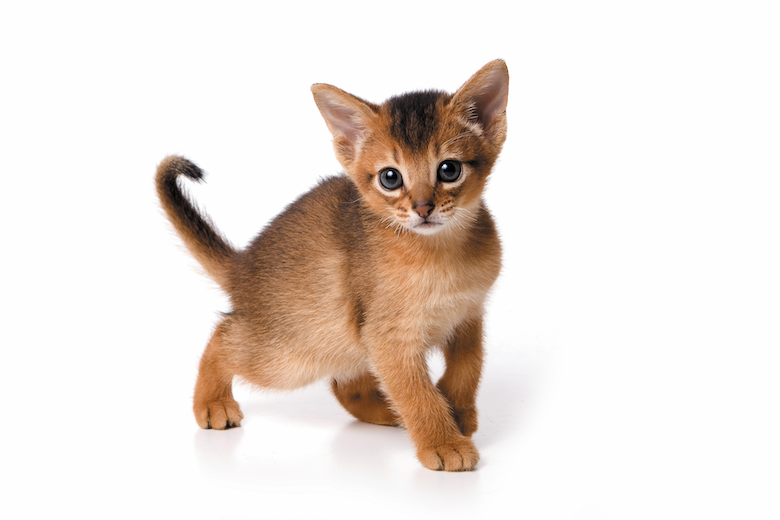
Highly trainable and amenable to walking on leash, the Abys is one of the most popular cat breeds. Photo: Dixi | Getty Images
Abyssinian
In the Abyssinian alphabet, A is for active, M is for mischievous and S is for super smart. The agile and athletic cats are known for their love of heights, lively nature and unquenchable curiosity. With a ticked coat, large ears, wedge-shaped head and lithe but muscular body, the Aby resembles his far distant ancestor, the African wildcat (Felis lybica).
Abys come in four colors: ruddy, red (also known as sorrel), blue and fawn. Some registries also recognize the colors silver, lilac and chocolate. Their green or gold eyes, with dark rims, offer a striking contrast.
The Aby is highly trainable and amenable to walking on leash. Expect him to set the pace, though. This entertaining cat isn’t shy about sharing his silly side, leading to the common nickname “Aby-silly-an.”
Weighing around 6 to 12 pounds makes him a medium-sized breed. Potential health problems include patellar luxation. Genetic diseases that can affect their quality of life are erythrocyte pyruvate kinase deficiency, amyloidosis and progressive retinal atrophy. Ask breeders if their cats are tested for these diseases. A healthy Abyssinian can live to 12 to 15 years or more.
This breed suffers from severe gingivitis (gum disease), known as “Aby mouth.” Stringent dental care is a must! Other grooming needs: Weekly brushing and regular nail trims.
Does well with: Many types of homes. However, his quick movements and tendency to wind between legs can make the breed a hazard around people who aren’t steady on their feet, including seniors and toddlers. Read more about the Abyssinian.
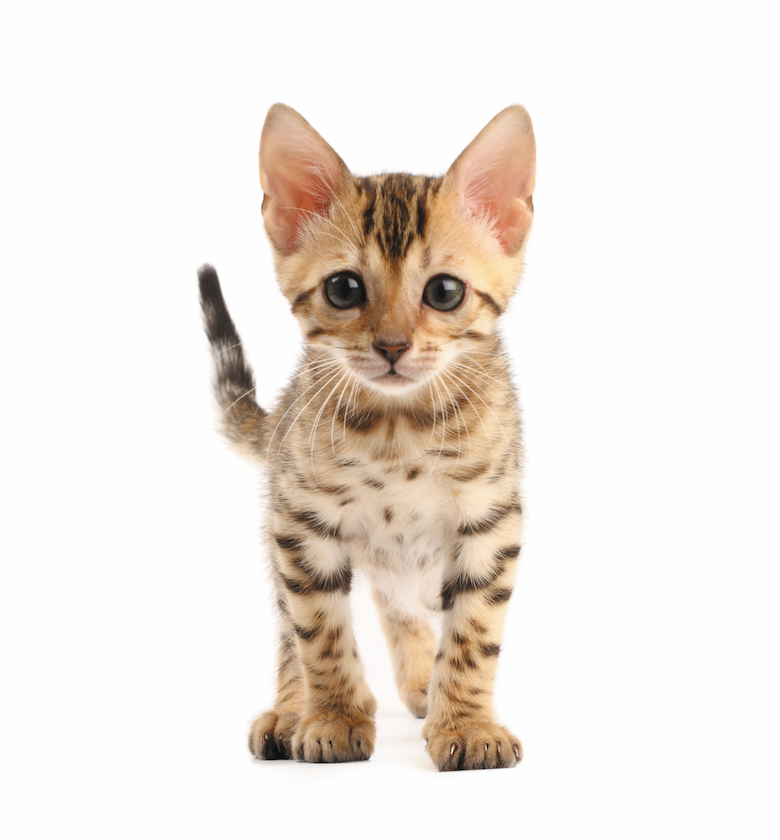
These highly intelligent and adore anything that gets their brains working cats are one of the most popular cat breeds. Photo: kipuxa | Getty Images
Bengal
The Bengal is wildly outgoing and one of the larger domestic breeds. Although a hybrid of an Asian leopard cat, Bengals are part of the domestic cat class. However, if you’re considering adding one to your family, the cat should be a minimum of four generations removed from wild bloodlines.
Bengals are athletes through and through, being both highly active and forever on the move. Water play is something they enjoy — whether taking showers or baths, playing in the sink or swimming alongside their humans.
Bengals are highly intelligent and adore anything that gets their brains working. Puzzle games are a big hit for them, but they can also be trained to do tricks by using the clicker method.
The Bengal is the only domestic cat breed that can be found with the type of rosette markings typically seen dotting the lush coats of its true wild counterparts — ocelots, leopards and jaguars. The rosettes appear as vivid cocoa, chocolate brown, rust, black or charcoal spots, or marbling resting on a contrasting background, such as buff, golden, sand, ivory, rust, brown or orange.
The Bengal is most frequently seen in the brown tabby pattern and occasionally in the marbled brown tabby pattern. They weigh in at 10 to 15 pounds.
Her coat is good with occasional brushing, although brush regularly in spring when shedding. Trim nails regularly.
Does well with: Kids and dogs — this breed is very affectionate! Read more about the Bengal.
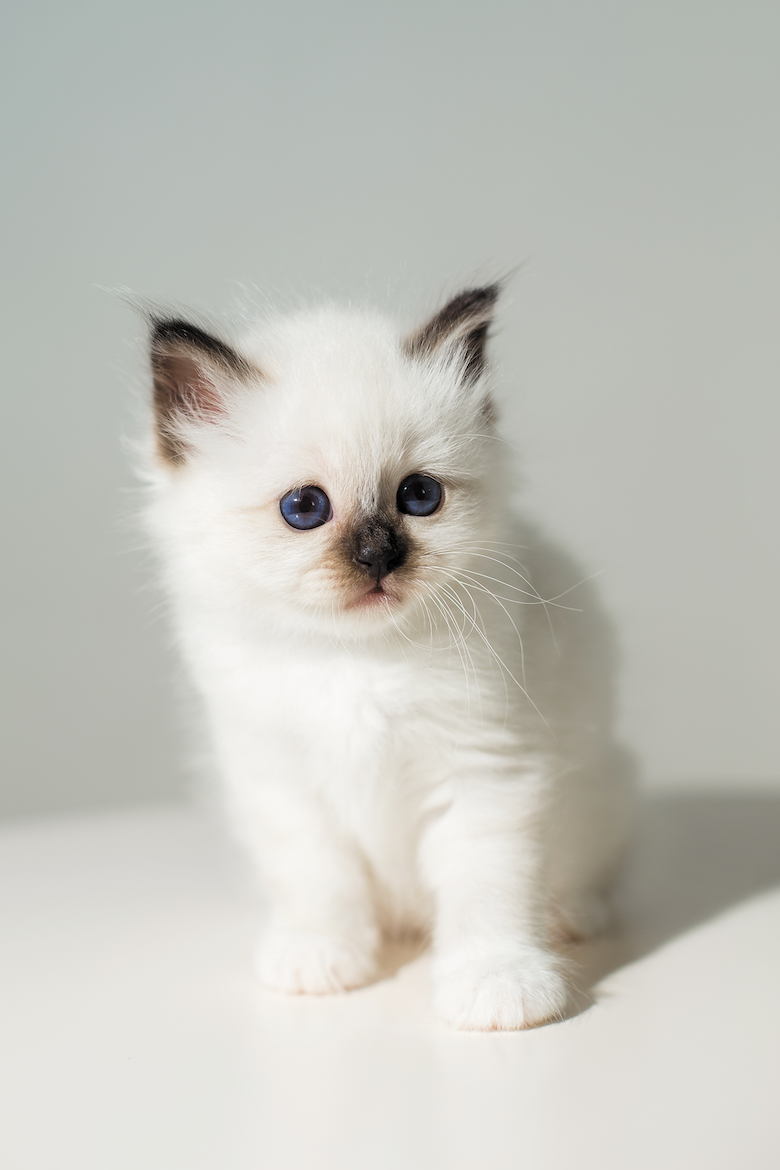
A healthy Birman can live 14 or more years. Read on to find out what makes this one of the most popular cat breeds. Photo: Vadimborkin | Getty Images
Birman
Wearing white gloves and a silky coat, the Birman might seem a bit la-di-da, but this beautiful semi-long-haired cat is a social butterfly who loves people. Fans say they are the ideal family cat.
Birmans are known for their pure white feet, in a pattern known as gloves (the white area on the front paws) and laces (the white that goes up the hind leg).
Birmans are attentive and affectionate and enjoy spending time with their family. They are happy to watch television with you for an afternoon, supervise in the kitchen or help your kids with their homework.
Birmans usually enjoy being handled and love children who treat them kindly and respectfully. With seniors or anyone else who would like a laid-back cat, they can be a gentle and companionable friend.
Birmans are generally healthy, but problems that may be seen in the breed include higher than normal levels of urea, creatinine or other waste products in the blood, which can be related to kidney disease and cardiomyopathy (a type of heart disease).
A healthy Birman can live 14 or more years. These medium-sized cats weigh 6 to 15 pounds, with males larger than females.
Grooming needs are simple. The silky single coat doesn’t typically form mats, but cats should be groomed weekly with a wide-toothed comb to remove dead hair and stimulate blood circulation for healthy skin and fur. Regularly trim nails.
Does well with: Families with children who treat her gently and seniors looking for an affectionate companion. Read more about the Birman.
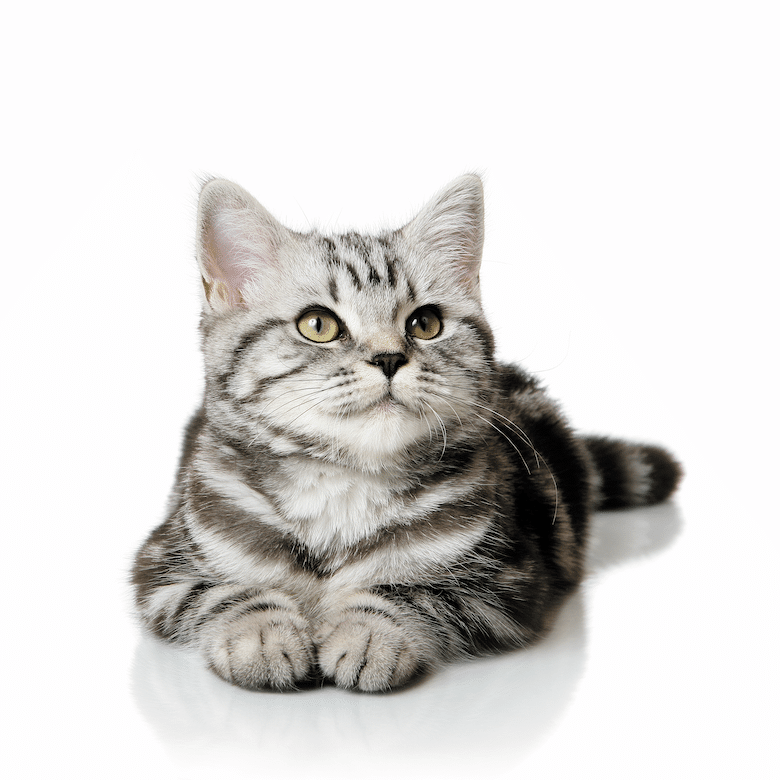
Known for their easygoing, affectionate, calm and quiet nature, it’s no wonder the British Shorthair is one of the most popular cat breeds. Photo: Viorika | Getty Images
British Shorthair
Chunky and full cheeked, the British Shorthair is a comfort cat: made for sitting in laps, twining around legs as meals are prepared and majestically stalking a toy mouse. With his large size and dignified demeanor, he is sometimes nicknamed the Winston Churchill of the cat world.
He’s best known for his easygoing, affectionate, calm and quiet nature. True to his British heritage, it takes a lot to ruffle his fur, making him a companion of choice for almost any family.
British Shorthairs are calm and prefer to live life with four on the floor. They are unlikely to jump on counters or climb the curtains, and they have a reputation as something of a klutz. The adult British Shorthair will snooze the day away while you’re at work, but he likes to be near, next to or on his people when they’re home.
The males weigh 9 to 17 pounds, with females slightly smaller at 7 to 12 pounds. It’s easy to let this breed become chubby, especially as he enjoys a sedentary lifestyle once past kittenhood. Don’t let him put on excess weight. British Shorthairs mature slowly and don’t reach full size until 3 years of age. They can live 14 to 20 years.
Grooming isn’t too bad: The thick coat doesn’t tangle and should be combed or brushed once or twice a week. Like most cats, he sheds, especially during spring and fall. Groom him more often during these times. Trim nails regularly.
Does well with: Other cats, dogs, rabbits and birds. Read more about the British Shorthair.
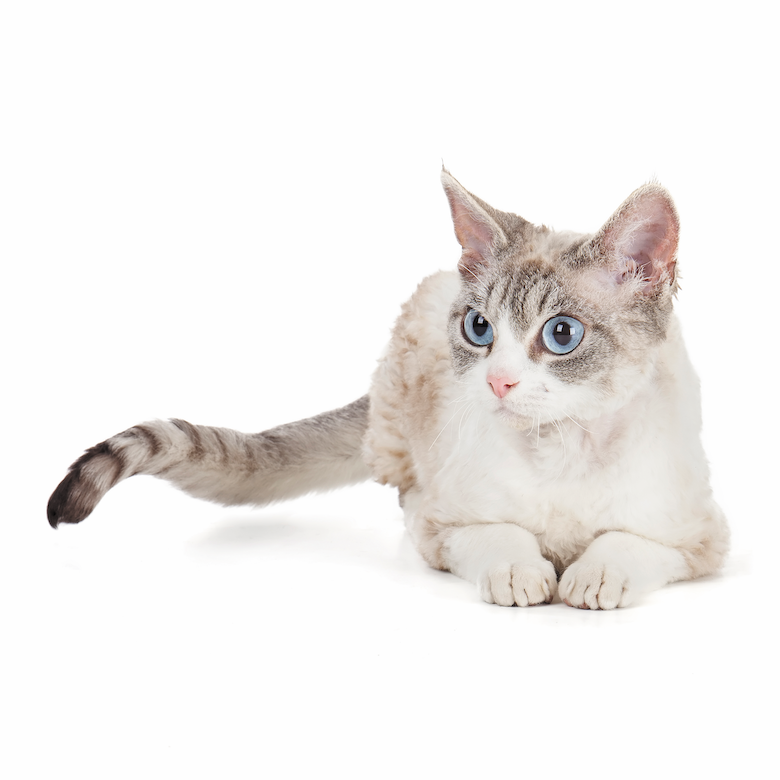
This is not the classic finicky feline. The Devon Rex loves to nosh off your plate and will try exotic items such as olives, asparagus tips or whatever he can get his paws on. Here’s why the Devon Rex is one of the most popular cat breeds. Photo: Vivienstock | Getty Images
Devon Rex
The Devon Rex looks as if he sprang straight out of a Japanese anime film. His triangular head, oversize ears and zany personality do little to deny that this is one unusual cat. He likes to ride on shoulders, learn tricks and chatter to you about his day. Clad in short, silky, fine hair, the Devon has a coat that can feel like soft suede, or it can have a whirled and curled appearance.
This social and curious cat loves the company of people and will be unhappy if left to his own devices. Fun-loving and playful, the Devon has been described as combining the traits of a cat, a dog, a monkey and Dennis
the Menace.
This is not the classic finicky feline. The Devon Rex loves to nosh off your plate and will try exotic items such as olives, asparagus tips or whatever he can get his paws on.
The Devon Rex has certain disease predispositions, including hypertrophic cardiomyopathy, the most common form of heart disease in cats; an orthopedic condition of the knees called medial patellar luxation; and hair loss resulting in permanent baldness. Small to medium size, the Devon Rex weighs from 6 to 9 pounds.
His coat molts as he matures from a kitten. The coat may also change seasonally. His shedding is less noticeable than that of many other cat breeds. For grooming, just rub his coat lightly with a chamois or simply run your hand over it. However, his naturally waxy ears need frequent cleaning. Trim nails regularly.
Does well with: People with allergies. Loves kids and gets along with all kinds of pets. Read more about the Devon Rex.
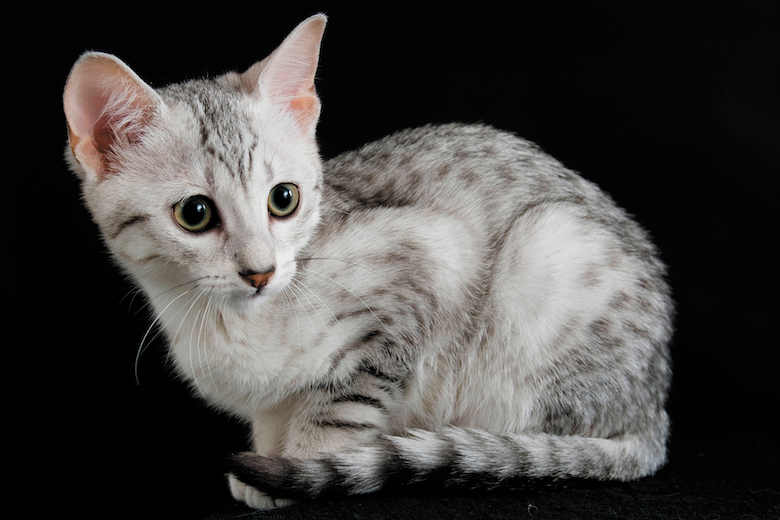
Though a social, people-loving sweetheart, this gal likes things on her terms, and she’s not afraid to vocalize that fact to you — at any time, day or night. Photo: Nina Reistad | Alamy Stock Photo
Egyptian Mau
If exotic-looking cats are the key to your heart, you’ll quickly fall in love with this spotted beauty. The Egyptian Mau has stripes and natural spots. In fact, it’s the only domestic breed to display such markings. And they correspond perfectly with the trio of natural colors the Egyptian Mau is found in — silver, bronze and smoke.
Though a social, people-loving sweetheart, this gal likes things on her terms, and she’s not afraid to vocalize that fact to you — at any time, day or night. A fiercely devoted and loyal feline, the Egyptian Mau loves to spend time with her squad, but she’ll remain most faithful to her “special person.” This breed is highly athletic and rough-and-tumble. She loves to climb, fetch, hunt and perch. One of the Egyptian Mau’s favorite pastimes? Water play! The Egyptian Mau is proof that cats don’t dislike water.
The Egyptian Mau’s hind legs are longer than her front legs, giving the illusion that she’s standing on her tiptoes (or wearing high heels). From a standing position, the Egyptian Mau can leap up to at least 6 feet in the air! She’ll also perch on your shoulder parrot-style and chortle sweet nothings (or confident demands for meals) in your ear. The Egyptian Mau has clocked in at 30 mph — clearly the reason why the breed is known as the Greyhound of the cat world.
This muscular, medium-sized breed ranges in weight from 7 to 9 pounds, with males weighing more. Grooming is simple: just a weekly brushing and regular nail trimming.
Does well with: People of all ages. The Egyptian Mau could easily be described as the family cat. Read more about the Egyptian Mau.
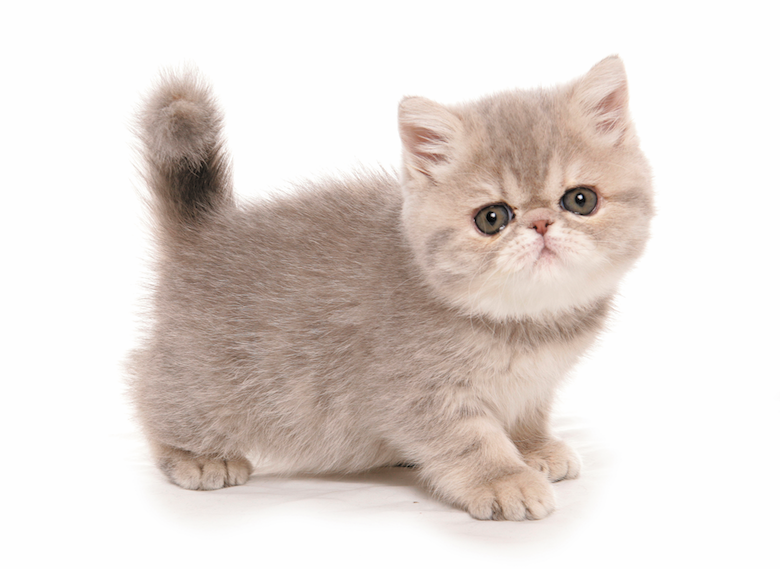
Plush and personable, the Exotic is one of the most popular cat breeds. Photo: petographer | Alamy Stock Photo
Exotics
Love a sweet and laid-back personality of the Persian but dread the thought of grooming one? Consider the Exotic. Plush and personable, the Exotic is aptly described as “the lazy person’s Persian.” This engaging and affectionate cat has a short, thick coat that’s beautiful but easy to groom. In personality, he’s more outgoing than the Persian but still maintains a mellow vibe.
Exotics are calm and easygoing, playful but not rowdy. They like to be in the same room with you but don’t demand attention — except for an incessant stare that you may be unable to resist.
Exotics pick up your habits. They’re waiting at the door when you get home, and they sleep when you sleep. The Exotic adapts to many types of homes and families as long as he gets lots of love and attention from people who appreciate his constant presence.
This medium-sized cat weighs around 8 to 13 pounds. Given good care and nutrition, an Exotic can live 10 to 14 years or more. These cats tend to mature more slowly than other breeds. Make sure your kitten’s parents have been tested clear of heart disease (hypertrophic cardiomyopathy), as well as polycystic kidney disease. Some may have mild eye issues or upper respiratory problems because of their flat facial structure.
Grooming is simple. Exotics have low-maintenance coats that don’t tangle easily. Comb their fur and give them a face wash weekly. Regularly trim nails.
Does well with: Families with kids and other pets or even someone who lives alone. Read more about the Exotic.
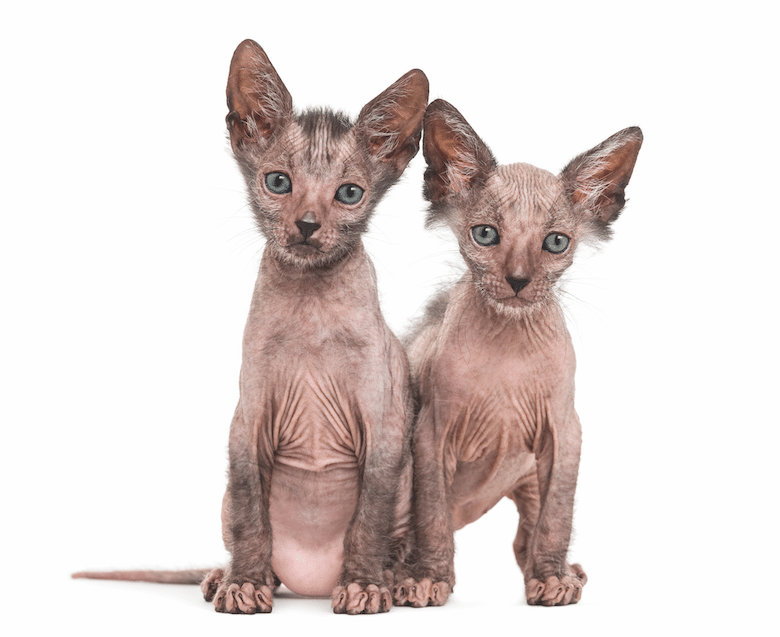
A new breed of cat, the Lykoi passed to Championship status in TICA in 2016 in the black roan color, which is the show standard. Photo: GlobalP | Getty Images
Lykoi
Known as the werewolf cat, this striking breed gets her unusual coat from a natural mutation in the domestic shorthair, which has occurred over the last 20 years in domestic cats. Not to worry: Test results show that the Lykoi’s hair pattern is not from a disease or disorder, and this breed is healthy. The name “Lykoi cat” is Greek for wolf cat.
A new breed of cat, the Lykoi passed to Championship status in TICA in 2016 in the black roan color, which is the show standard. As of 2018, the cats could be shown in the CFA under Miscellaneous Status.
This breed lacks an undercoat and has less hair than most cats. The black roan coat is two tone as an adult — equal parts white and black — although she is born solid black. There may be more coat colors in the future, so stay tuned.
Living up to the name, this wolf cat likes to hunt, along with playing fetch. Loving and loyal, she is very social and likes to talk. She’s an intelligent cat, aware of her surroundings — best for people who like a cat by their side.
Males are larger than females, weighing from 10 to 13 pounds. Females weigh from
5½ to 9 pounds.
Similar to hairless cats, the amount of bathing needs depends upon the amount of oils produced.
These natural oils pool in the ears, so regularly clean them. The oils also build up on the claws and can be simply cleaned off. Nails need regular trimming. This isn’t a hypoallergenic cat. She sheds and can go bald from time to time.
Does well with: Families and other animals, when properly introduced. The Lykoi likes companionship. Read more about the Lykoi.
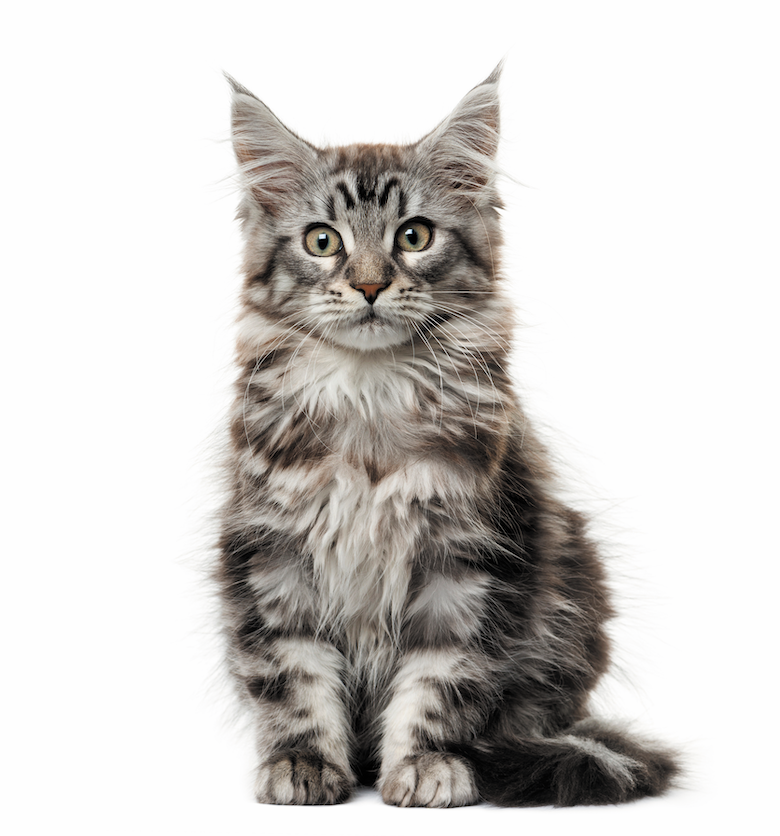
These big cats can weigh from 9 to 18 pounds. Photo: Nynke van Holten | Getty Images
Maine Coon
This furry “cat of size” takes his name from the tall tale that he’s the result of a love match between a cat and a raccoon. Brown tabby fur and ringtail notwithstanding, the Maine Coon is indeed all cat — a very large armful of cat. Nicknamed the “gentle giant,” the Maine Coon is right up there with Siberians, Norwegian Forest Cats and Ragdolls as one of the largest of pedigreed felines. The “gentle” part comes from his famously laid-back personality.
Maine Coons enjoy chasing toys and will bring them back to you. If you need pest control, the Maine Coon’s “barn cat” ancestry can make him your new best friend. A Maine Coon will follow you around and offer assistance, but he’s not an in-your-face kind of cat. He’s not always a lap sitter, but he may enjoy “holding paws” with you. The Maine Coon prefers to keep four on the floor. He’s a curious cat and can take well to learning to walk on a leash. He enjoys playing in water, although that doesn’t always translate to enjoyment of a bath.
These big cats can weigh from 9 to 18 pounds, with males being larger. A Maine Coon can live 12 to 15 years, with some living well into their late teens. Health problems may be hip dysplasia and hypertrophic cardiomyopathy.
Regular brushing must be on the to-do list. Trim nails regularly.
Does well with: Kids and other pets. Read more about the Maine Coon.
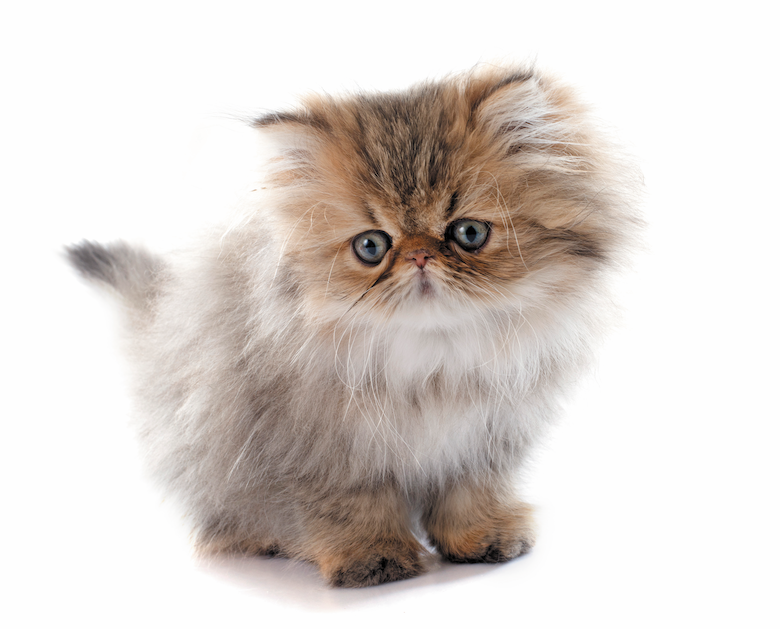
The sweet and quiet Persian is one of the most popular cat breeds. Photo: cynoclub | Alamy Stock Photo
Persian
The sweet and quiet Persian enjoys sitting in a lap, receiving gentle petting from her admirers. Known for her luxurious coat and affectionate manner, she prefers family members over strangers. Choose a Persian if you want a cat who’s not a climber and if you don’t mind daily grooming.
Persians prefer a quiet, serene environment. They don’t mind children who handle them carefully and respectfully. They use their soft, pleasant voice to mention politely that it’s mealtime or that they’d like to have some play, please, with their favorite peacock feather. As long as she receives attention when you’re home, the Persian is content to rule her domain from a comfortable sofa or chair while family members are at work or school.
Their flat faces can cause Persians to suffer a variety of health problems, including noisy or difficulty breathing; excessive tearing of the eyes; sensitivity to heat; and dental malocclusions. Purchase a kitten whose parents have been tested free of polycystic kidney disease.
Persians typically weigh between 7 to 10 pounds, with males being larger than females. Healthy Persians live 12 to 17 years.
The Persian’s long, beautiful coat must be combed and brushed daily to prevent mats and tangles. A regular bath is also a good idea. Wipe corners of the eyes daily to prevent staining from excessive tearing. Regularly trim nails.
Does well with: Families with gentle, quiet children and seniors. Read more about the Persian.
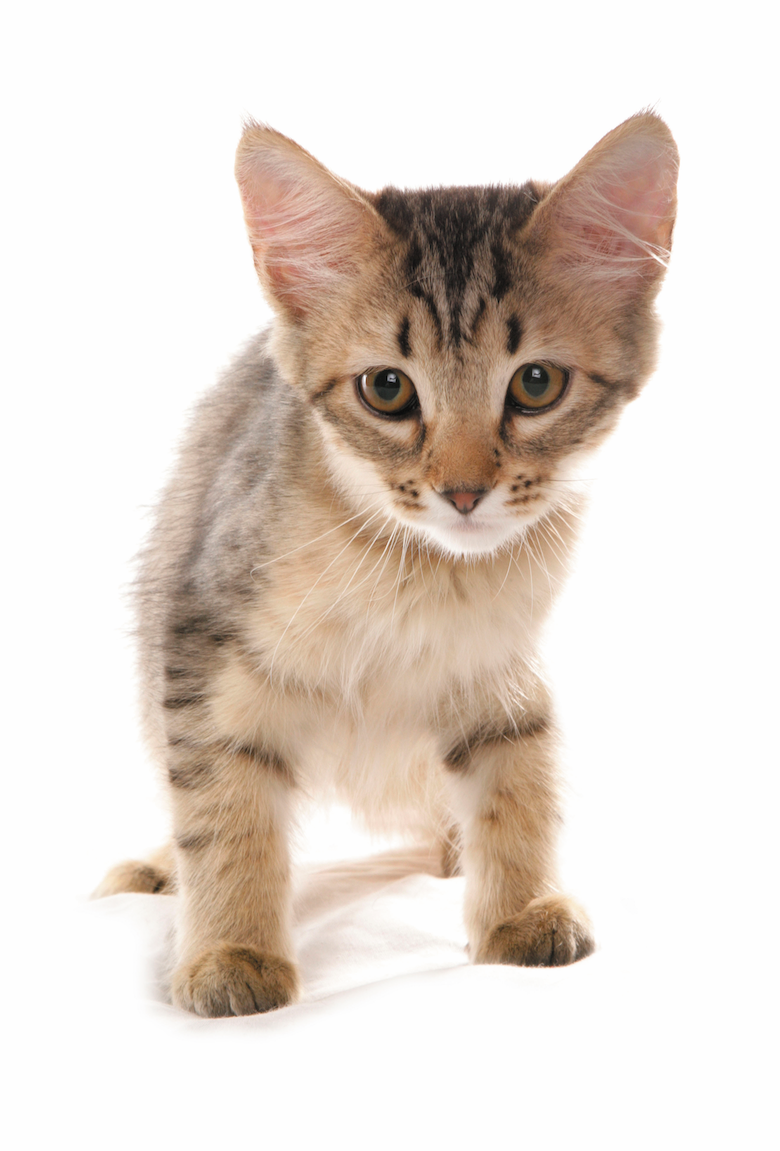
These active cats are one of the most popular cat breeds. Photo: petographer | Alamy Stock Photo
Pixiebob
Tufted ears like his namesake, the bobcat, a brown-spotted tabby coat and, of course, a bobbed tail come together in the Pixiebob, a relatively new cat breed created to give the impression of wild blood without the actual presence of it. This breed’s distinctive appearance includes white markings around the eyes that resemble spectacles; facial fur that gives the cat the appearance of sporting “mutton chops”; gold, brown or gooseberry green eyes; a rolling gait when he walks; and a primordial belly pouch. Most Pixiebobs have some variation of a short tail, which can have kinks, knots, curlicues or simply be straight.
These active cats prefer being at “heart level” so they can help you or keep you company in whatever you’re doing. Pixiebobs want to be with you, near you or on you but without being obnoxious about it. They are smart and highly trainable. Pixiebobs enjoy conversing with people.
In addition to the standard meows and purrs, they chatter, chirp and chuff. They also like to go for car rides. Most Pixiebobs enjoy playing in water and don’t even mind getting a bath.
The Pixiebob is a large cat, weighing between 10 to 18 pounds. Approximately 25 percent of Pixiebobs are polydactyl, meaning they have extra toes. They can have as many as seven toes on each foot. It can take four years for a Pixiebob to achieve full physical maturity.
Grooming is easy with a weekly brushing, though do it more often for the medium- or long-haired variety to avoid mats or tangles. Trim nails regularly.
Does well with: Families, kids and other pets. Read more about the Pixiebob.
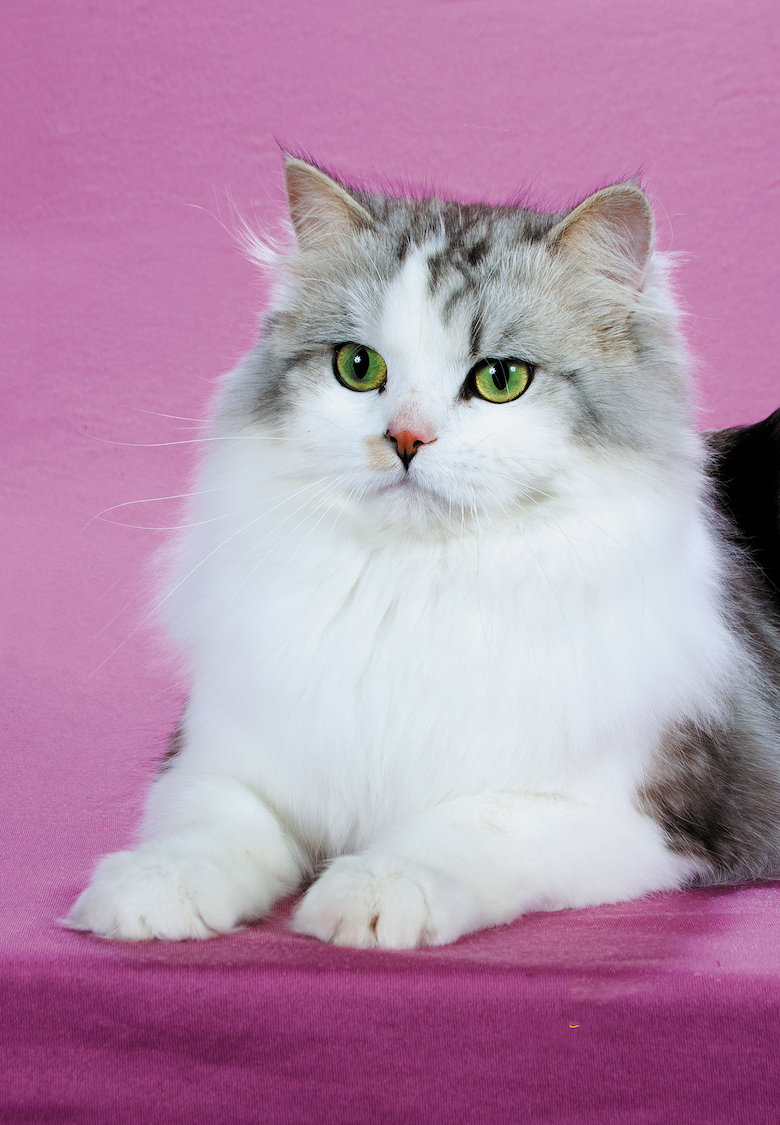
Calm and easygoing this is one of the most popular cat breeds. Photo: Larry Johnson
RagaMuffins
RagaMuffins are so laid-back and sweet, you just want to eat them up. These gentle giants of the cat world love nothing more than a good lap and an admiring audience. The extremely friendly cats — who can approach or even exceed the size of a small dog — are sweet and mellow. If you’re looking for a pet to cuddle with, these people- loving felines are the cat’s meow.
Calm and easygoing, they’ll do what you want to do, whether that’s learn to walk on a leash or have a tea party with the kids. While the “rag” in the name is an allusion to a habit of going limp in people’s arms, it doesn’t mean he can be dragged around like a ragdoll. This substantial cat should be held and carried properly by supporting his hind end.
The RagaMuffin needs lots of love and attention from people who appreciate his constant presence. He does best when given plenty of playtime, training and attention. Don’t get a RagaMuffin if you‘d be annoyed by his strong desire to be in your lap.
One of the largest breeds, the RagaMuffin can weigh from 8 to 20 pounds, with males being larger. RagaMuffins come in all coat colors and patterns. Their large, expressive eyes, which may be slightly slanted, can be any color. Some have odd eyes, meaning each eye is a different color, a condition known as heterochromia.
Brush his teeth, as he can be prone to periodontal disease. Groom coat weekly and regularly trim nails.
Does well with: Cats, dogs and kids; makes a good companion for seniors. Read more about the RagaMuffin.
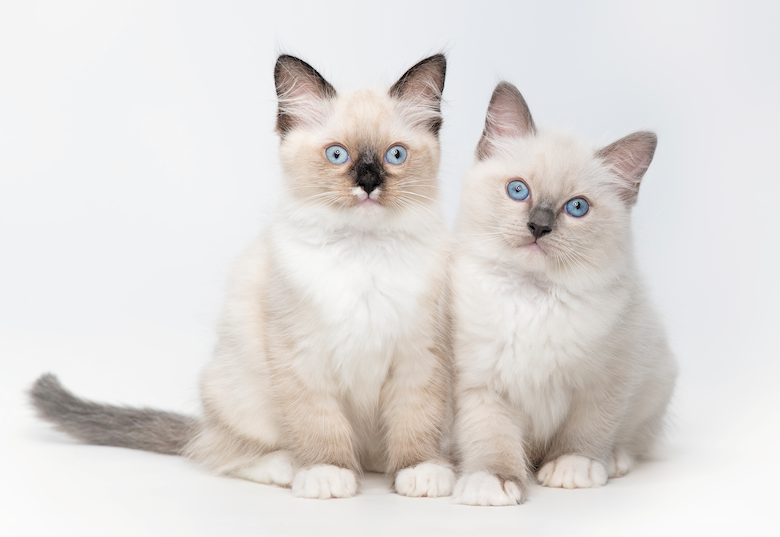
Ragdolls like doing anything that involves their humans. Read on to find out why this is one of the most popular cat breeds. Photo: Thomas Leirikh | Getty Images
Ragdoll
It’s easy to fall into the depths of a Ragdoll’s glowing, sapphirine eyes, but the real enchantment of these pointed cats with the silky medium-length coat is their gentle and affectionate personality. The Ragdoll has a reputation for being a lap cat par excellence.
People looking for a quiet, laid-back cat to travel with them in an RV or be their work-at-home companion will find the people-loving Ragdoll to be a good choice. Although she won’t mind snoozing the day away if you have to go off to work, she’ll want to be with you or near you when you’re at home.
Ragdolls like doing anything that involves their humans, including playing fetch, coming at a run when called and exploring the outdoors on a leash. Choose this breed if you’d like a cat who stays at ground or sofa level rather than climbing to the highest point in your home.
Among the largest of cat breeds, this kitty can weigh from 10 to 20 pounds. The life span of a healthy Ragdoll is 15-plus years. Ragdolls can be prone to a common feline heart condition called hypertrophic cardiomyopathy. Cats with the gene that causes the disease can be identified through a DNA test, allowing conscientious breeders to produce cats free of the condition. It’s not true that Ragdolls are resistant to pain. Like any cat, they can be hurt or feel discomfort.
Brush this breed several times a week. The coat sheds in spring and fall. Regularly trim nails.
Does well with: Families with children who treat her gently. Will buddy up with dogs as well as other cats. Read more about the Ragdoll.
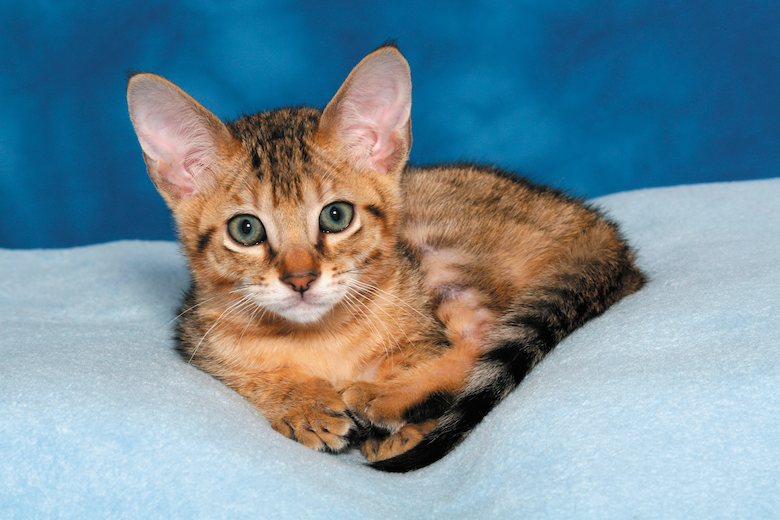
These affectionate and outgoing cats are one of the most popular cat breeds. .Photo: Tierfotoagentur | Alamy Stock Photo
Savannah
Love the look of a wild cat? The large, active and confident Savannah has a spotted coat and large pointed ears, giving her an exotic appearance. The serval is in her ancestry, but she’s not wild herself. She is, however, adventurous, intelligent and curious — a cat who’s more than a handful. Savannahs need lots of playtime, opportunities to jump and climb, and tough, sturdy toys.
Savannahs are affectionate and outgoing. They love their family, including kids, other cats and friendly dogs. Expect a Savannah to enjoy playing in water; you may discover her turning on water faucets or splashing in her water dish.
Don’t be surprised if she takes to walking on a leash or learning tricks, including retrieving toys. But beware, Savannahs can be destructive if they don’t receive enough playtime or mental stimulation.
These cats have a sense of humor and are known to play tricks on people: They will hide and reach out and bop you as you walk by, dip a favorite toy into your coffee cup and set off the alarm at your bedside.
Savannahs are large cats. Their weight ranges from 15 to 20 pounds, with males being larger than females. This breed is generally healthy, and grooming needs are simple. Brush their short coat weekly, and regularly trim nails. They have an expected life span of 13 or more years.
Does well with: Active families who give her plenty of attention and training; dogs and other cats if raised with them. Not for first-time cat owners. Read more about the Savannah.
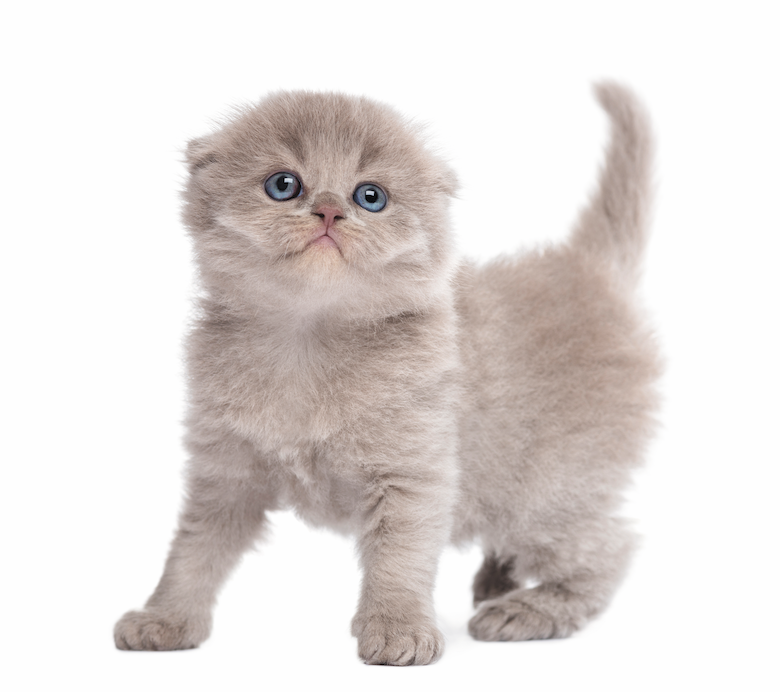
Mild-mannered, soft-spoken, intelligent, adaptable and sweet-tempered this is one of the most popular cat breeds. Photo: GlobalP | Getty Images
Scottish Fold
Dubbed an “owl in a cat suit” by breeders, the Scottish Fold has earned a reputation as one adorable specimen given her perma-Cheshire Cat grin, soulful yet oversized eyes and folded ears.
All Scottish Folds are born with straight ears. It’s not until they are 3 or 4 weeks of age that their ears fold downward — although sometimes they simply don’t. Scottish Folds are known to feature a very round, roly-poly aesthetic. Face, eyes, whisker pads, body — it’s all circular here.
The Scottish Fold is exceptionally devoted and loyal, forming a strong bond with one person in the household. That’s not to say he won’t cuddle with anyone who throws a kiss his way, but Scottish Folds do play favorites.
Known for a laid-back personality, they have zero travel issues and are mild-mannered, soft-spoken, intelligent, adaptable and sweet-tempered. The Scottish Fold can be trained to play fetch and easily learn how to open cabinet doors — so lock up what you don’t want him to find.
Some funny quirks: Scottish Folds are known to stand up prairie dog style when they hear something that piques their interest. You also can catch them in a sitting position called “the Buddha sit” with their legs stretched out and paws on their belly. Many also eat food with their paws. Don’t be alarmed if they flop down onto their back and hit the snooze button — it’s completely normal for them to sleep this way.
The Scottish Fold weighs in from 6 to 13 pounds, with males being heavier. Grooming is a simple weekly combing and regular nail trimming.
Does well with: Kids, dogs and other cats. Read more about the Scottish Fold.
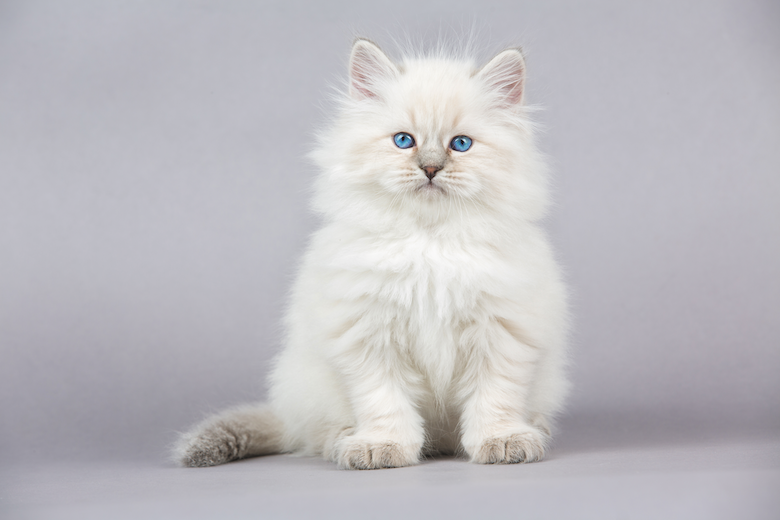
Siberians love to play chase and tag but are gentle when being handled for grooming or medication. Read on to discover why this is one of the most popular cat breeds. Photo: jkitan | Getty Images
Siberian
The Siberian moves like a Bolshoi Ballet dancer, with supple grace and strength. Known as the national treasure of Russia, this large, long-haired cat hails from Siberia, which is undoubtedly why her coat consists of three dense layers. But don’t think she’ll be cool to your overtures. Siberians are affectionate, outgoing, smart and curious.
Siberians like to play in water and can learn to enjoy taking a bath. They also are good at learning to walk on a leash, as they are explorers by nature. These agile cats are awesome jumpers, thanks to hind legs that are slightly longer than their front legs. They have soft voices and express themselves in trills, chirps, mews and purrs.
Siberians love to play chase and tag but are gentle when being handled for grooming or medication. Siberians are good mousers and ratters. If no mice are available, they love playing with toys. A Siberian does best when given plenty of playtime, training and attention. This cat will stick near you, but don’t get a Siberian if you want a lap cat.
One of the larger breeds, Siberians weigh between 9 and 18 pounds, with males being larger. A Siberian can live 11 to 15 years or more. Siberians have a reputation for being hypoallergenic because some (but not all) produce less Fel d 1, the protein that causes people to be allergic to cats. Spend plenty of time with the Siberian you plan to get to make sure you don’t react to her.
This breed sheds copiously in spring and fall. Regularly brush her fur (more during shedding season) and trim her nails.
Does well with: Other cats and dogs; enjoys playing with kids. Read more about the Siberian.
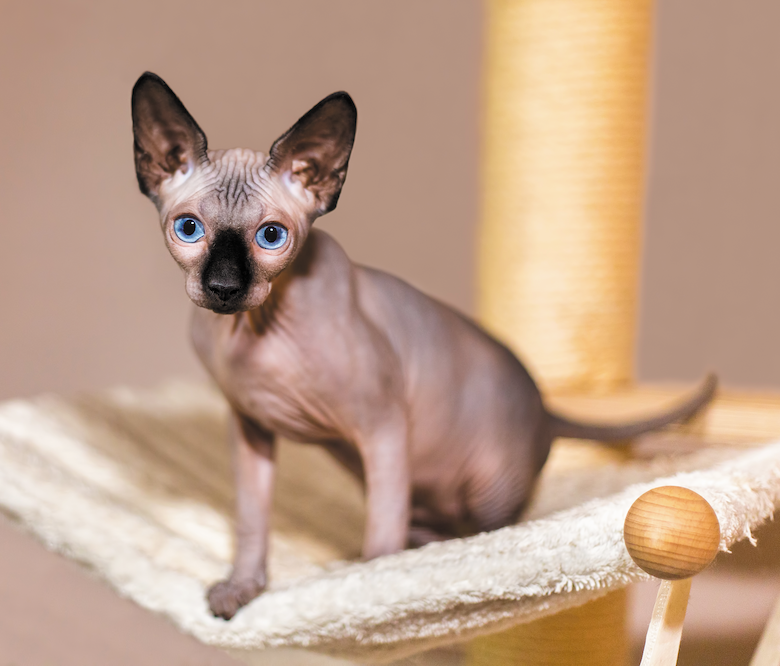
This interesting cat is one of the most popular cat breeds. Photo: Ben-Schonewille | Getty Image
Sphynx
This interesting cat stands out for more than his hairless and wrinkly body. He bears a distinct resemblance to an alien — a friendly one! — with his large, satellite-dish ears and multiple skin tones and patterns. Another characteristic of the breed is a potbelly, so don’t assume that one you’re seeing is overweight. The Sphynx feels like suede beneath your hand.
The Sphynx is acrobatic, devoted, lively and mischievous. He is also affectionate and lovable, following you wherever you go, including the bathroom. Sphynx cats are sociable and enjoy meeting your neighbors, relatives and friends. The best home for a Sphynx is one with lots of love and attention and where he has a warm lap, cozy bedding or a sweater to keep him from getting cold.
The Sphynx is not necessarily hypoallergenic. Like any cat, he produces an allergenic protein called Fel d 1, which is distributed in his saliva and through his sebaceous glands. But, some find Sphynxes easier to be around.
This breed weighs in around 6 to 11 pounds, with males being larger. A healthy Sphynx can live 14 years or more. Watch out for a heart condition called hypertrophic cardiomyopathy and a skin condition called cutaneous mastocytosis.
The Sphynx can be prone to gingivitis, so brush teeth frequently for fresh breath and good dental health. He needs regular bathing to remove oily secretions from his skin. Eyes, ears and claws must be cleaned regularly.
Does well with: Kids and other pets. Read more about the Sphynx.
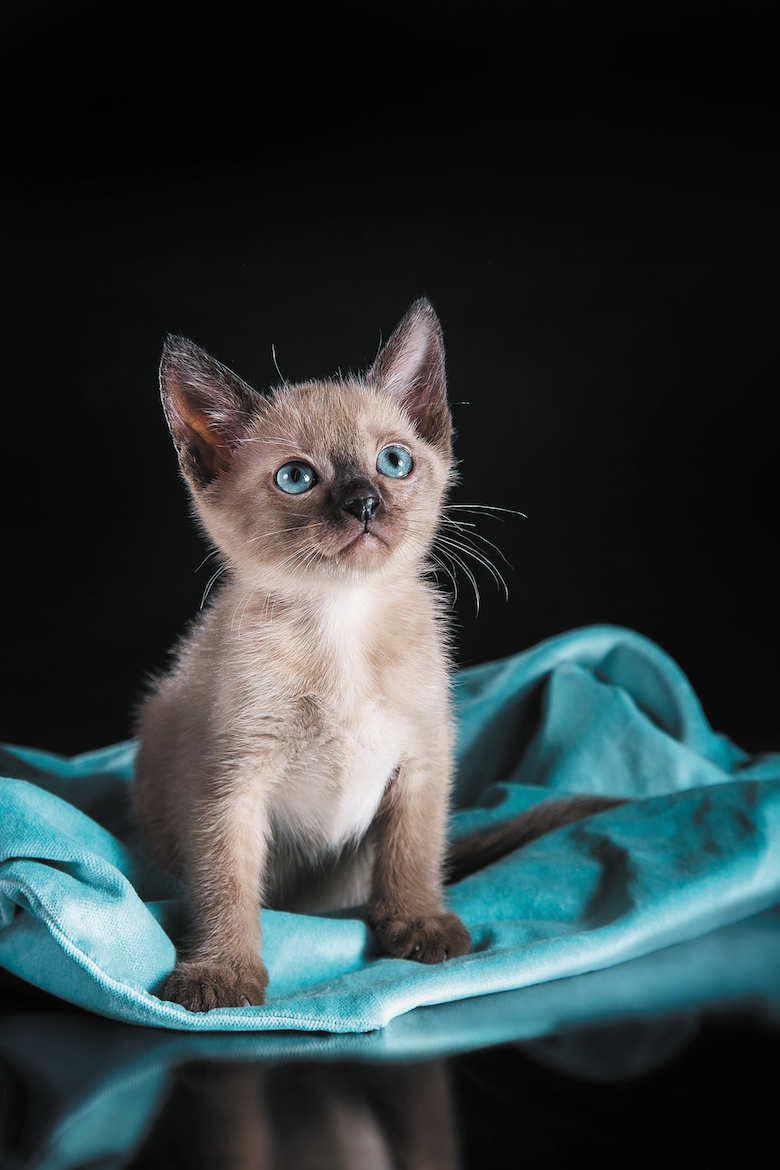
With gem-colored eyes and a plush coat this is one of the most popular cat breeds. Photo: Anna-av | Getty Images
Tonkinese
With gem-colored eyes and a plush coat, the Tonkinese is an exotic blend of the Siamese and the Burmese. Mischievous and affectionate, active but also willing to snuggle in a lap, the Tonkinese wants to be your best friend. A Tonk will supervise as you prepare meals, load the dishwasher or post his latest pics and videos on Instagram and YouTube. His friendly nature makes him a good candidate for therapy visits to hospitals, schools and other facilities.
These social and curious cats enjoy fetching toys or socks and being the center of attention, so it’s not difficult to teach them tricks or to walk on a leash. They have a softer voice than the Siamese but are equally willing to carry on a conversation.
Tonkinese come in three coat patterns (solid, pointed and mink) and four different color points (platinum, champagne, blue and natural) for a total of 12 different looks, which develop as they mature.
This breed is medium-sized, weighing from 6 to 12 pounds. Generally hardy and healthy, Tonks are prone to gingivitis, so regular tooth brushing and professional dental cleanings by a veterinarian are important. The cats may also be sensitive to anesthesia. A healthy Tonkinese can live 15 to 18 years.
The short and plush coat is easy to care for — brush weekly with a rubber curry brush. Trim nails regularly.
Does well with: Families with children who will treat him kindly and respectfully, other cats and dogs. Read more about the Tonkinese.
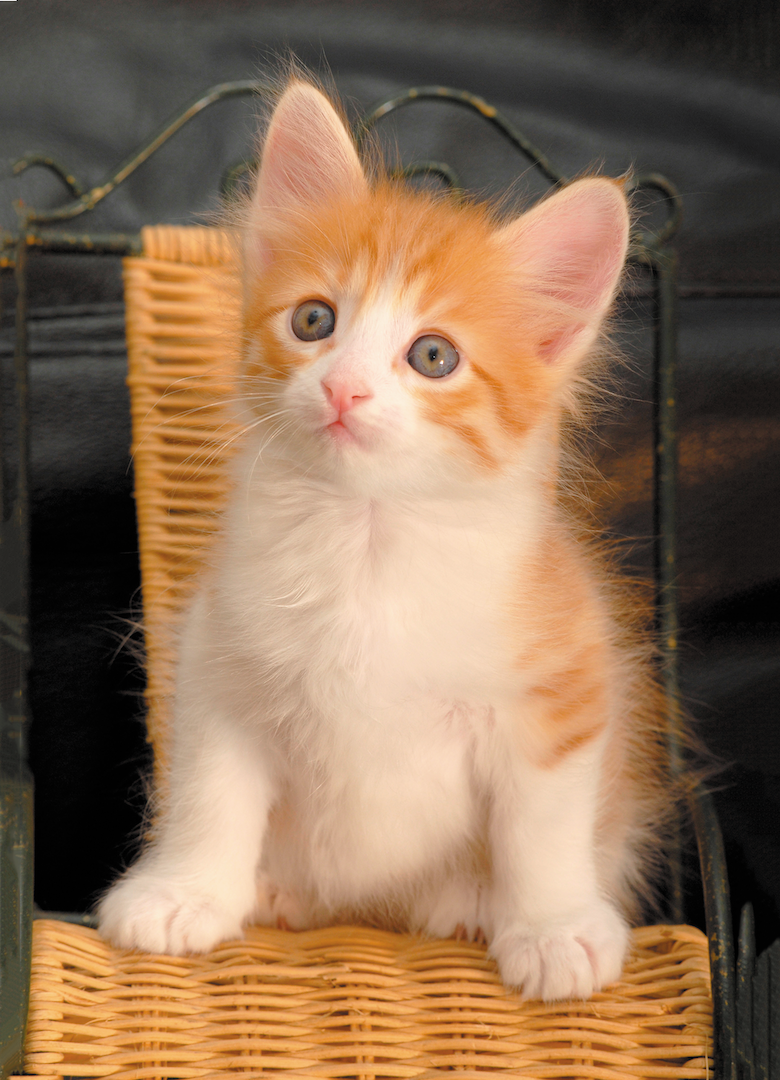
It’s clear why this fairy-tale princess of a cat is one of the most popular cat breeds. Photo: Marka | Alamy Stock Photo
Turkish Angora
The Turkish Angora seems to be a fairy-tale princess of a cat: beautiful, long fur; eyes as blue as a mountain lake; a loving heart. But Turkish Angoras are much, much more than they seem on the surface: more mischievous, more colorful, more intelligent and more athletic than their looks might imply.
An affectionate nature means that the Turkish Angora will demand to be involved in everything you do, “chatting” with you about how you should do things. This cat has a sense of humor and isn’t above playing tricks on her people.
Inquisitive and active, the Turkish Angora, fortunately, is also graceful. So with luck, she won’t break your belongings when she leaps onto the mantel to go exploring. Some top agility cats are Angoras.
She plays fetch, learns tricks, teaches herself to turn on the sink faucet and more. The Turkish Angora likes to have her own way and, once she gets an idea about something, it’s hard to change her mind.
This breed weighs from 5 to 10 pounds and is generally healthy. Congenital deafness and transfusion reactions because of the type B blood are the main concerns to be aware of. Some but not all white cats with blue eyes or odd eyes may be deaf in the ear that’s on the same side as the blue eye. This doesn’t affect the ability to be a good pet, although they may meow more loudly than other cats because they can’t hear themselves. With good health and care, Turkish Angoras can live 15 to 20 years.
Groom once or twice a week. The silky coat is easy to comb and doesn’t mat easily. Don’t forget to regularly trim nails.
Does well with: Kids and other pets. Read more about the Turkish Angora.
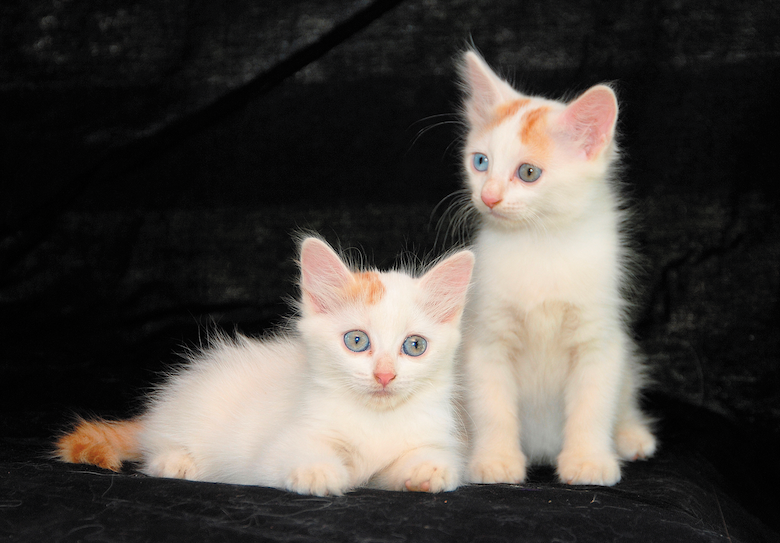
This rare but ancient breed is one of the most popular cat breeds. Photo: ©Marka | Alamy Stock Photo
Turkish Van
Can’t decide between a cat or a dog? Get a Turkish Van, a smart, agile and curious cat who will play fetch and learn commands and tricks. This rare but ancient breed loves attention from his human, but he’s not about being held. This is not the breed for you if you prefer a quiet, sedate lap cat.
You need to be quick on your feet with a Turkish Van around. This is a smart cat, who loves to run, play and jump, usually to the highest point in the room. Although not big on cuddling, he does like to be petted and will follow his favorite person around. There is a reason they call this breed the “swimming cat.” He loves splashing around in any water he finds around the house. But be aware, the Turkish Van can be a bit of a handful for those who aren’t prepared for this breed.
This is a cat of substantial size and strength. Weight ranges between 7 to 20 pounds, with males being larger. He has a beautiful, semi-long-haired coat that is water-resistant. The coat doesn’t mat easily, so it just needs a weekly combing. Regularly trim nails. The Turkish Van can live to around 13-plus years.
Does well with: Those who understand he doesn’t like to be cuddled or carried, although petting is fine. Does well with other pets if they are OK with him being in charge. Read more about the Turkish Van.
Read Next: 5 Weird Kitten Behaviors Explained